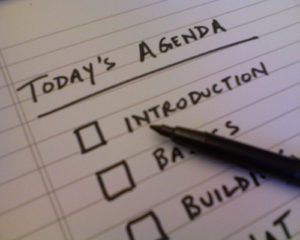9.5 Management of Teams
[Author removed at request of original publisher] and Venecia Williams
Learning Objectives
- Understand key concepts in managing teams.
- Understand how to create team norms, roles, and expectations.
- Identify the key to running effective team meetings.
Key Concepts in Managing Teams
In Linda A. Hill’s Harvard Business Review article “Managing Your Team” (HBR, 1995), she discusses that managing a team means managing paradox. A paradox exists in the fact that teams have both individual and collective identities and goals. Each individual has goals and ideas as to what he wants to accomplish—on the project, in one’s career, and in life. The team itself, of course, has goals and success metrics that it needs to meet in order to be successful. Sometimes these can be in conflict with each other. Competition may arise among team members, and a win-loss attitude may take place over a collaborative and problem-solving team dynamic. The team manager may need to step in to help integrate all of the individual differences to enable them to productively pursue the team goal. Therein lies the primary paradox—balancing individual differences and goals AND the collective identity and goals. Other paradoxes include:
- Fostering support AND confrontation among team members
- Focusing on performance AND learning and development
- Balancing managerial authority AND team member discretion and autonomy
- Balancing the Triangle of Relationships—manager, team, and individual
Managing a team also means managing its boundaries. Managing the team’s boundaries—or space between the team and its external forces, stakeholders, and pressures—is a delicate balance of strategy, stakeholder management, and organizational behaviour. The team manager must serve, in part, as a buffer to these external factors so that they don’t derail or distract the team from its goals. However, the manager must also understand enough about the external environment and have enough emotional intelligence to understand which forces, players, or situations must be synthesized within the team for its own benefit. Think about any medium or large-scale change initiative that you have been a part of in your career. Ideally, there is generally a vision for change and a level of sponsorship at the senior levels of the organization that is supposed to pave the way for that change to take root. The project team is officially “blessed” to kick off the team, create a charter, and identify the needed actions to drive the initiative to successful completion.
The dynamic that ensues after the kickoff is really what will determine the success of the team. There are numerous stakeholders in any organization, and many will be pro-change initiative, but others may be against the initiative—either due to lack of understanding or concerns about losing power, territory, etc. The external environment and business strategy may not be particularly well suited for a change initiative to take place, and so there may be the feeling of forces opposing the project team efforts. A strong team manager needs to manage these “boundaries” with the organization to help the team navigate through and with the organizational complexities, goals, nuances, and egos that are a part of any organization. In Linda A. Hill’s Harvard Business Review article “Exercising Influence,” she states that “managers also need to manage relationships with those who are outside their team but inside their organizations. To do so, they must understand the power dynamics of the larger organization and invest time and energy in building and maintaining relationships with those on who the team is dependent.” It is also, in her view, “the manager’s job, at a minimum, to educate others about organizational structures, systems, or politics that interfere with the team’s performance.” With all of the potential external influences on a team, managing a team’s boundaries can truly mean the difference between success and failure.
The final element of managing a team is to manage the team itself—both the people elements and the process elements, or task at hand. The process-focused elements include managing the work plan to reach the overall goal, as well as the incremental meetings and milestones that are a part of the team’s journey to reach the longer-term goal. Keeping the team focused on its objectives—beginning with setting agendas all the way to managing project tasks and celebrating milestones—assures that the team will stay on track. Projects and initiatives vary in size, scope, and complexity, and so the project management tools shouldn’t be prescribed in a general sense. The important takeaway here is to choose an approach and a tool that works for the culture of the team and the organization, and that helps the team understand where they are, where they need to go, and what resources are a part of that process.
In managing the team members and interpersonal dynamics, there is the important element of selecting the right team members, shaping the team’s norms and culture (how are decisions made, what are our rules, how do we manage conflict, etc.), and coaching the team. Defining the right skill sets, functions, perspectives, and expertise of the members will ensure a solid foundation. Helping the team to identify and formalize the ground rules for team engagement will help manage in the face of adversity or team conflict in the future. Finally, playing a role as a supportive coach will help both the individual team members and the group entity think through issues and make progress towards goals. A coach doesn’t solve the individual/team problem but helps the team think through a solution and move forward. Teams may need guidance on how to work things out within the team, and the manager must provide feedback and hold team members accountable for their behaviour and contribution. Continuous improvement is the name of the game. A team may not start out as high performing, but they can certainly achieve that goal if everyone is focused on incremental improvements to communication, collaboration, and performance.
Establishing Team Norms
Team Norms
Norms are shared expectations about how things operate within a group or team. Just as new employees learn to understand and share the assumptions, norms, and values that are part of an organization’s culture, they also must learn the norms of their immediate team. This understanding helps teams be more cohesive and perform better. Norms are a powerful way of ensuring coordination within a team. For example, is it acceptable to be late for meetings? How prepared are you supposed to be at the meetings? Is it acceptable to criticize someone else’s work? These norms are shaped early during the life of a team and affect whether the team is productive, cohesive, and successful.
Square Wheels Exercise and Group Discussion
Sometimes it can be challenging to start a conversation around team ground rules and performance. The following exercise can be used to get individuals talking about what works and what doesn’t work in teams they’ve worked in and how your team can be designed most effectively.
What is happening in this picture represents how many organizations seem to operate. On a piece of paper have everyone in your team write on this form and identify as many of the key issues and opportunities for improvement as you can. Following this, have a conversation around what this illustration might mean for your own team.
Team Contracts
Scientific research, as well as experience working with thousands of teams, show that teams that are able to articulate and agree on established ground rules, goals, and roles and develop a team contract around these standards are better equipped to face challenges that may arise within the team (Katzenback & Smith, 1993; Porter & Lilly, 1996). Having a team contract does not necessarily mean that the team will be successful, but it can serve as a road map when the team veers off course. The following questions can help to create a meaningful team contract:
-
Team Values and Goals
- What are our shared team values?
- What is our team goal?
-
Team Roles and Leadership
- Who does what within this team? (Who takes notes at the meeting? Who sets the agenda? Who assigns tasks? Who runs the meetings?)
- Does the team have a formal leader?
- If so, what are his or her roles?
-
Team Decision Making
- How are minor decisions made?
- How are major decisions made?
-
Team Communication
- Who do you contact if you cannot make a meeting?
- Who communicates with whom?
- How often will the team meet?
-
Team Performance
- What constitutes good team performance?
- What if a team member tries hard but does not seem to be producing quality work?
- How will poor attendance/work quality be dealt with?
Team Meetings
Anyone who has been involved in a team knows it involves team meetings. While few individuals relish the idea of team meetings, they serve an important function in terms of information sharing and decision making. They also serve an important social function and can help to build team cohesion and a task function in terms of coordination. Unfortunately, we’ve all attended meetings that were a waste of time and little happened that couldn’t have been accomplished by reading an email in 5 minutes. To run effective meetings, it helps to think of meetings in terms of three sequential steps (Haynes, 1997).
Before the Meeting
Much of the effectiveness of a meeting is determined before the team gathers. There are three key things you can do to ensure the team members get the most out of their meeting.
- Is a meeting needed? Leaders should do a number of things prior to the meeting to help make it effective. The first thing is to be sure a meeting is even needed. If the meeting is primarily informational in nature, ask yourself if it is imperative that the group fully understands the information and if future decisions will be built upon this information. If so, a meeting may be needed. If not, perhaps simply communicating with everyone in a written format will save valuable time. Similarly, decision-making meetings make the most sense when the problem is complex and important, there are questions of fairness to be resolved, and commitment is needed moving forward.
- Create and distribute an agenda. An agenda is important in helping to inform those invited about the purpose of the meeting. It also helps organize the flow of the meeting and keep the team on track.
- Send a reminder prior to the meeting. Reminding everyone of the purpose, time, and location of the meeting helps everyone prepare themselves. Anyone who has attended a team meeting only to find there is no reason to meet because members haven’t completed their agreed-upon tasks knows that, as a result, team performance or morale can be negatively impacted. Follow up to make sure everyone is prepared. As a team member, inform others immediately if you will not be ready with your tasks so that they can determine whether the meeting should be postponed.
During the Meeting
During the meeting, there are several things you can do to make sure the team starts and keeps on track.
Figure 9.16

- Start the meeting on time. Waiting for members who are running late only punishes those who are on time and reinforces the idea that it’s OK to be late. Starting the meeting promptly sends an important signal that you are respectful of everyone’s time.
- Follow the meeting agenda. Veering off agenda communicates to members that the agenda is not important. It also makes it difficult for others to keep track of where you are in the meeting.
- Manage group dynamics for full participation. As you’ve seen in this chapter, a number of group dynamics can limit a team’s functioning. Be on the lookout for full participation and engagement from all team members, as well as any potential problems such as social loafing, group conflict, or groupthink.
- Summarize the meeting with action items. Be sure to clarify team member roles moving forward. If individuals’ tasks are not clear, chances are that role confusion will arise later. There should be clear notes from the meeting regarding who is responsible for each action item and the time frames associated with the next steps.
- End the meeting on time. This is vitality important, as it shows that you respect everyone’s time and are organized. If another meeting is needed to follow up, schedule it later, but don’t let the meeting run over.
Figure 9.17

Conducting meetings standing up saves time yet keeps information flowing across the team (Bluedorn, Turban, & Love, 1999). This technique is used by Johnson & Johnson Services Inc., Ritz-Carlton Company LLC, ThoughtWorks Inc., Agile Software, and Corning Inc. Karlis Dambrans
After the Meeting
- Follow up on action items. During the meeting, the participants probably generated several action items. It is likely that you’ll need to follow up on the action items of others.
Attribution
This chapter contains content from Organizational Behavior, which is an OpenStax resource licensed under a Creative Commons Attribution 4.0 International (CC BY) license.
Key Takeaway
Much like group development, team socialization takes place over the life of the team. The stages move from evaluation to commitment to role transition. Team norms are important for the team process and help to establish who is doing what for the team and how the team will function. Creating a team contract helps with this process. Keys to address in a team contract are team values and goals, team roles and leadership, team decision making, team communication expectations, and how team performance is characterized. Team meetings can help a team coordinate and share information. Effective meetings include preparation, management during the meeting, and follow-up on action items generated in the meeting.
Exercises
- Have the norms for most of the teams you have belonged to been formal or informal? How do you think that has affected these teams?
- Have you ever been involved in creating a team contract? Explain how you think that may have influenced how the team functioned.
- Should the person requesting a meeting always prepare a meeting agenda? Why or why not?
- Do you think conducting team meetings standing up is a good idea? Why or why not?
References
Bluedorn, A. C., Turban, D. B., & Love, M. S. (1999). The effects of stand-up and sit-down meeting formats on meeting outcomes. Journal of Applied Psychology, 84, 277–285.
Haynes, M. E. (1997). Effective meeting skills. Menlo Park, CA: Crisp.
Katzenback, J. R., & Smith, D. K. (1993). The wisdom of teams. Boston, MA: Harvard Business School.
Linda, L.A., (1995). Managing Your Team. Boston, MA: Harvard Business School Publishing.
Linda, L.A., (1994). Exercising Influence. Boston, MA: Harvard Business School Publishing.
Porter, T. W., & Lilly, B. S. (1996). The effects of conflict, trust, and task commitment on project team performance. International Journal of Conflict Management, 7, 361–376.


